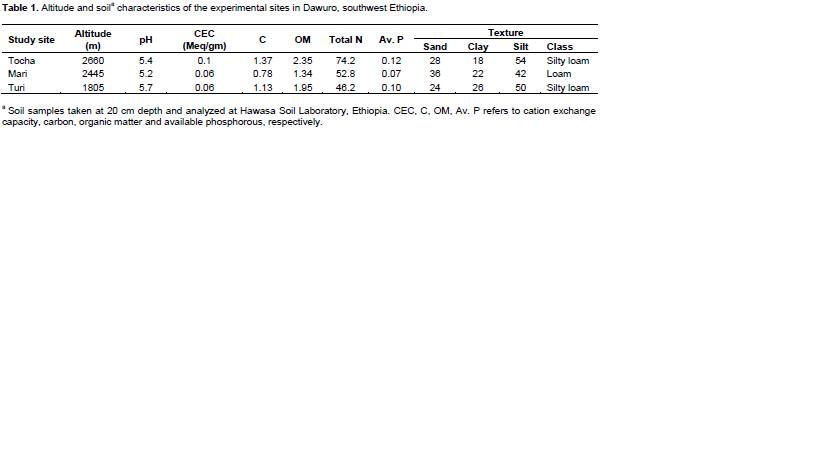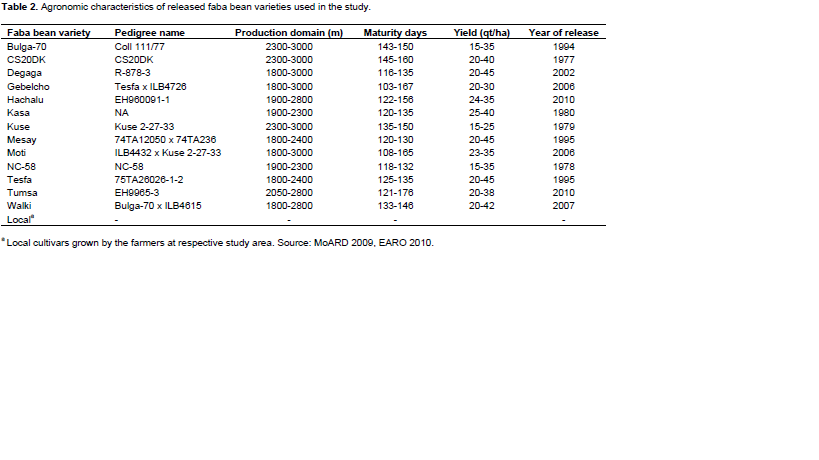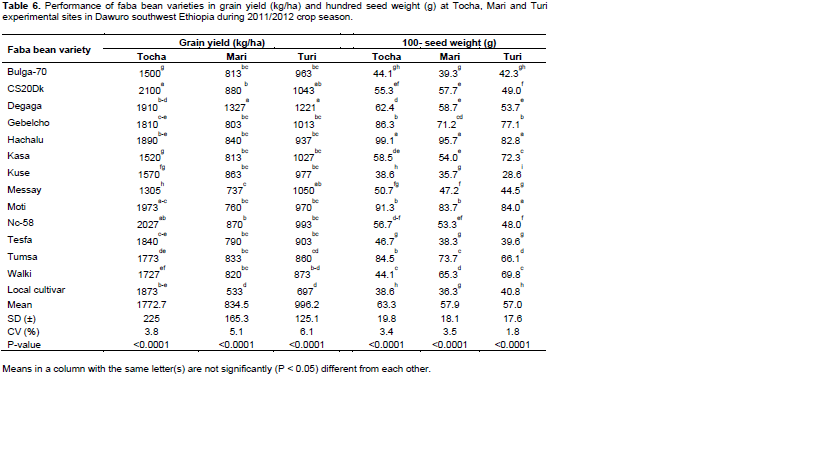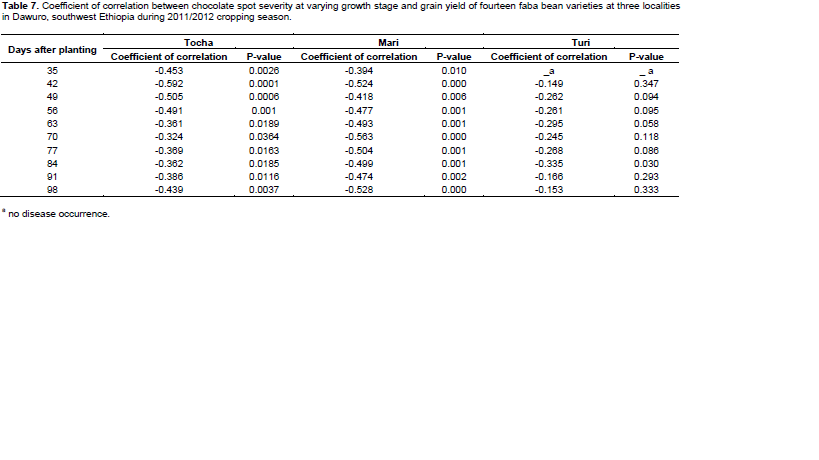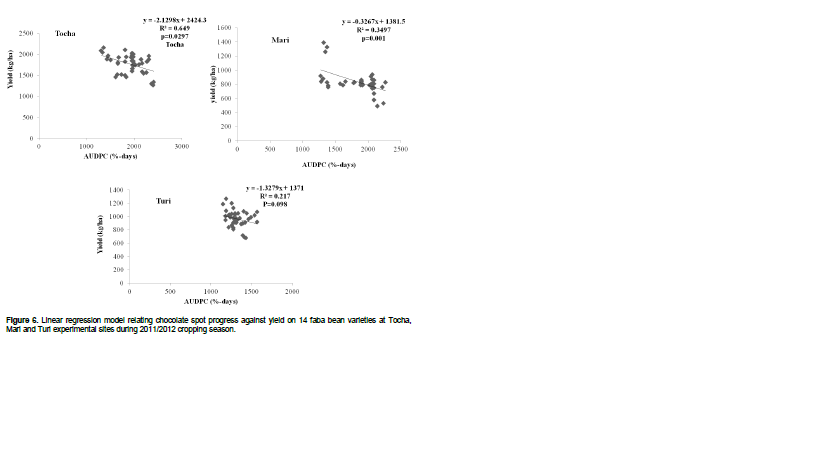ABSTRACT
Chocolate spot (Botrytis fabae Sard.) is one of the major diseases menacing faba bean (Vicia faba L.) production and restraining its productivity in Ethiopia and other African countries. The yield losses reach up to 100% on susceptible cultivars. Although a number of faba bean varieties with good yield potential have been released, their reaction to this major disease and yield performance are little understood in southwest Ethiopia. Thus, chocolate spot epidemics on 13 improved faba bean varieties were studied under natural infections at three sites varying in altitudes from 1805 to 2660 m in the Dawuro zone of southwest Ethiopia. The field experiments consisted of 14 treatments (13 varieties and a local cultivar) are laid out in a randomized complete block design (RCBD) with three replications (40 plants/plot) during the 2011/2012 crop season. The onset and progress of chocolate spot severity was assessed (with a 1-9 scale) every seven days until the epidemic attained peak and then grain yield and 100-seed weight were recorded and statistically analysed. The varieties varied significantly (P < 0.001) in disease severity index, AUDPC and infection rates (r) values, grain yield and 100-seed weight. CS20DK, Degaga, Nc-58, Bulga-70, Tesfa and Kasa exhibited high to moderate resistance to chocolate spot with consistently slow progression and terminal disease severity, AUDPC- and r-values at all testing sites. The yield performance of CS20DK and Degaga were also superior at Tocha and Turi while Nc-58 (2027 kg/ha) and Moti (1973 kg/ha) that showed susceptible reaction gave good yield only at Tocha. This study indicated that improved faba bean varieties reacted differently to chocolate spot infection and yield potentials across varying localities, and thus better performing varieties such as CS20DK, Degaga and Nc-58 are recommended for faba bean production in southwest Ethiopia.
Key words: Botrytis fabae, evaluation, improved varieties, Vicia faba.
Faba bean (Vicia faba L.) has been grown in the highlands of Ethiopia between 1800 and 3000 m above sea level (a.s.l.) for many decades and the country is now considered as one of the centers of secondary diversity for the crop (Agegnehu et al., 2006). The crop occupies the largest areas among legumes and the total area under cultivation is estimated to be about 512,067 ha from which 200,000 metric tonnes of grain yield is harvested (FAOSTAT, 2010). The primary producers of pulses are small-scale farmers with small and dispersed plots under rain-fed conditions with substantially lower yields of less than 0.9 t/ha as compared to the improved faba bean varieties and international yields.
Chocolate spot (Botrytis fabae Sard.) is the major fungal disease hampering faba bean production in Ethiopia (Dereje and Yaynu, 2001; Sahile et al., 2010). It is a highly prevalent and destructive disease, causing yield loss up to 61% on a susceptible and 34% on tolerant faba bean genotypes in the central highlands (Dereje and Yaynu, 2001). Sahile et al. (2010) reported even higher losses of 67.5% in the unsprayed faba bean plots in northwest Ethiopia.
The extent of chocolate spot damage and genetic diversity of B. fabae has been less understood in southwestern parts of Ethiopia although many research activities, including development and release of improved faba bean varieties, have been undertaken in the cereal-pulse based farming system of the central highlands of the country. To-date, more than 20 improved varieties with grain yield varying between 1.8 to 4.0 t/ha have been released for production. The newly developed varieties include CS20DK, Kusse-2-27-33, Bulga 70, NC-58, Kassa, Tesfa and Degaga (MoAR, 2009). However, the adoption of these improved faba bean varieties has been challenged by many biotic and abiotic factors, in particular by chocolate spot (B. fabae) infections. Besides the considerable differences in soil and weather conditions across faba bean belts, there exists wide variation in pathogenicity among B. fabae populations collected from diverse regions (Dereje, 1996). Sahile et al. (2012) indicated differences in virulence among 76 B. fabae isolates collected from faba bean fields in northern Ethiopia.
The production of the crop is enormously declining as the local faba bean cultivars are entirely attacked by chocolate spot and other diseases in southwest Ethiopia. The deployment of resistant varieties to this calamitous disease is one of the management approaches and in order to identify the resistant varieties, the test genotype has to be assessed under naturally occurring heavy disease zones (hot spot) and through artificial infection (Bond et al., 1994; Villegas-Fernandez et al., 2009). In this study, the epidemics of chocolate spot (B. fabae) on 13 improved faba bean varieties was carried out under field conditions across three altitudinal gradients. The performance of the improved varieties vis-vis the respective local cultivars/landraces in reaction to the disease and their yield potential are discussed.
Description of the study sites
Chocolate spot epidemics were studied on thirteen released faba bean varieties and a local cultivar under field conditions in three districts representing potential faba bean producing areas of the Dawuro zone in southwest Ethiopia during the 2011/2012 crop season. The sites were Tocha, Mari and Turi situated at varying altitudes between 1800 and 2660 m a.s.l (Table 1) and characterized by wet and humid climatic conditions where chocolate spot is known to be consistently prevalent and severe on local cultivars.
Faba bean varieties G
Seeds of thirteen improved faba bean varieties with relatively high yield (1.5 – 4.0 t/ha) that had been released for production between 1978 and 2010 (MoARD, 2009; EARO, 2010) were obtained from Holleta Agricultural Research Center, Ethiopia. A ‘local cultivar’ commonly grown by farmers in the respective study areas was included as a susceptibility check (Table 2).
Land preparation, planting and field management
The faba bean varieties were sown (2 seeds /hill) on properly prepared land at a recommended population density of 250,000 plants/ ha at 10 cm (between plants) × 40 cm (between rows) (EARO, 2010) in July 2011. In order to ensure the disease occurrence and enhance the natural infections, a row of a chocolate spot susceptible local cultivar was planted between each plot. This practice is reported to induce early disease development on local checks which can later serve to spread the pathogen spores to adjacent test entries (ICARDA, 1986; Bouhassen et al., 2004). The experimental plots were arranged in a randomized complete block design with three replications while each plot had four rows with 10 plants/row. The recommended agronomic practices like weeding were uniformly applied to each plot throughout the study period. Faba bean plants in the central two rows were used for disease assessment, yield and yield related measurements.
Disease assessment
Chocolate spot severity was recorded on each of eight sample plants from middle two rows in each plot, using 1 – 9 scale; where, 1 = no lesions or covering up to 1% of leaf surface; 3 = lesions covering 1 – 2 % of leaf surface; 5 = lesions common (3 – 5 mm in diameter), covering 2 – 5% of leaf surface; 7 = lesions that cover 5 – 10 % of leaf surface; 9 = extensive lesions, covering more than 10% of the leaf surface (ICARDA, 1986; Hanounik, 1986). The disease was scored at weekly intervals starting from the first chocolate spot symptom appearance and continued until the final podding stage when the disease attained maximum (Sahile et al., 2008; Villegas–Fernandez et al., 2012). Finally, the scores were converted into disease severity index (DSI) for the analysis (Hanounik, 1986; Ayman et al., 2009; Abo-Hegazy et al., 2012). Based on DSI values, the response of tested varieties were classified into six reaction groups following Abo-Hegazy et al. (2012); where 0 – 2% is highly resistant (HR), >2 – 15% resistant (R), >15 – 40% moderately resistant (MR), >40 – 60% is moderately susceptible (MS) and >60 – 80% is susceptible (S) >80 – 100% highly susceptible (HS).
Yield data
In addition to disease data, the varieties were evaluated for yield and related components. Grain yield (gm/plot) and 100- seeds weight were recorded from plants in the central rows of each plot at harvest, and finally the yield was converted to kg/ha before statistical analysis.
Disease epidemics analysis
The progress of chocolate spot was plotted over time using mean severity indices for each faba bean variety at each location, and the DSI values were also used for the two important epidemiological analyses, namely, area under disease progress curve (AUDPC) and apparent infection rate (r). The AUDPC values (%-day) were calculated for each variety according to the mid-point rule formula (Berger, 1981; Campbell and Madden, 1990).

Where Yi is the disease severity index (DSI) of chocolate spot at ith assessment date, Ti is the time of the ith assessment in days from the first assessment date and n is the total number of disease assessments. Because severity was in percentage and time in days, AUDPC was expressed in proportion days.
The apparent infection rate, expressed in disease units per day, was calculated first by converting DSI values to a proportion on a scale of 1 to 9 and then transformed to logistic model (ln [(Y/1-Y)]) (Van der Plank, 1963) where Y and 1-Y represent the proportion of infected plants and the proportion of healthy plants remaining in the plot, respectively. The transformed values (y) were regressed against time (x) to determine the model (Campbell and Madden, 1990).
Statistical analysis
The disease severity values (DSI, AUDPC, r), seed yield (kg/ha) and 100-seed weight (gm/plot) were analysed and treatment means were compared with SAS software version 9.2 (SAS Institute, 2008). The relationship among the disease parameters with seed yield was tested using simple correlation-regression analysis.
Chocolate spot appearance and epidemics
The earliest characteristic symptoms of chocolate spot, which are small discrete reddish-brown sunken lesions on the upper side of the leaves, appeared first on the susceptible local faba bean cultivar in the spreader rows at the Tocha and Mari experimental sites both situated at higher altitudes (>2445 m a.s.l.). Subsequently, the disease developed on some of the improved varieties such as Hachalu, Messay and Walki, 20 days after planting (DAP) at the same sites while it occurred a week later (27 DAP) at Turi (1805 m a.s.l.).
The disease severity indices analysis showed significant (P < 0.01) differences among the 13 faba bean varieties at all assessment dates between 35 and 98 DAP in the three sites (Table 3). Chocolate spot severity was significantly lower (< 23%) on CS20DK and Degaga followed by Tesfa and Bulga-70 while the local cultivar and most of the improved varieties Hachalu, Kuse and Gebelcho showed higher disease infections ranging from 42 to 45% at Tocha particularly 63 DAP (Figure 1). Similarly, there were distinct differences among the faba bean varieties in the disease progression at Mari where the severity levels were more pronounced on all plants of the local cultivar; Moti, Messay and Nc-58 during all the successive assessments 56 DAP as opposed to that of CS20DK, Tesfa and Degaga (Figure 2). In general, the final chocolate spot severity was significantly different (P < 0.05) among the varieties at Turi (Figure 3) though the infection values were lower than that of Mari and Tocha.

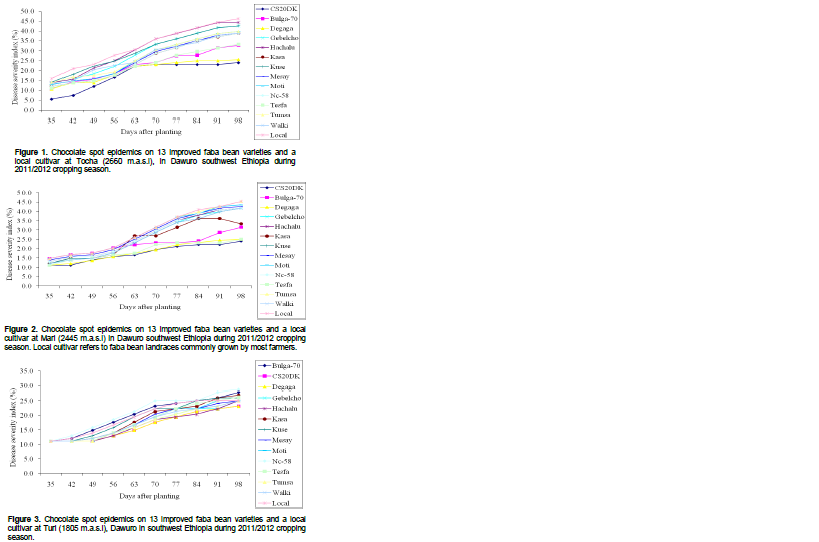
The highest chocolate spot infections on the local cultivars were 46.3 and 45.0% at Tocha and Mari, respectively, as opposed to the lowest mean severity of 24.1% on CS20DK and 25% on Degaga at both sites (2445 to 2660 m a.s.l) (Table 4). Hachalu and Kuse varieties had relatively high infection values of 44.4 and 42.6% similar to the local susceptible check. Bulga-70 and Tesfa had moderate infections that varied from 31.5 to 32.8 and 25.0 to 33.3% at Tocha and Mari, respectively (Table 4). Nevertheless, maximum disease severity of 28.7% was recorded on Nc-58 and it was not significantly different from other varieties except from that of CS20DK and Degaga in the field at Turi (Table 4).
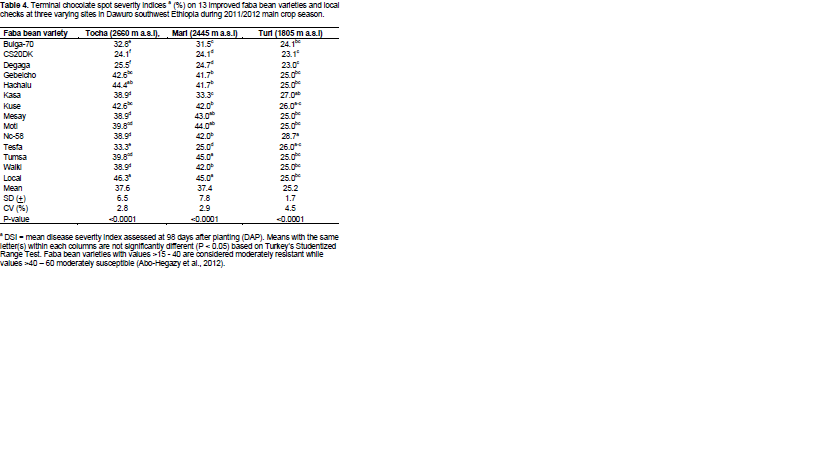
Accordingly, the four faba bean varieties namely CS20DK, Degaga, Bulga-70 and Tesfa expressed relatively moderate to high resistance to chocolate spot at Tocha and Mari under heavy disease pressure.
Area under disease progress curve (AUDPC) of chocolate spot
The area under disease progress curve (AUDPC) values for chocolate spot was significantly (P < 0.01) different among the faba bean varieties tested at all locations. The overall AUDPC values ranged from 1289 to 2387 proportion - days for CS20DK and the local cultivar at Tocha and Mari (Figures 4 and 5). Faba bean varieties CS20DK and Degaga followed by Bulga-70 and Tesfa had low disease accumulation revealed by significantly (P < 0.05) least mean AUDPC values in contrast to Hachalu, Gebelcho, Tumsa and the local susceptible checks at both sites (Figures 4 and 5).

Chocolate spot infection rates
The logistic model that provided the best fit and the mean apparent infection rate (r) of chocolate spot varied significantly (P < 0.05) among the varieties at the three sites (Table 5). Low infection rates of 0.110, 0.118 and 0.104 disease units per day were computed for Degaga, CS20Dk and Tesfa, respectively at Mari; and for the former two varieties at Turi (0.118 disease units per day). Degaga showed consistently slower infection rate across the three sites while CS20DK has shown slightly varied response, faster disease development at Tocha but slower at Mari and Turi (Table 5). The regression equations with coefficient of determinations (R2) ranging from 73.8 to 97.3% were calculated when the severity indices were regressed over time in days after planting for all faba bean varieties (Table 5).
Grain yield and 100-seed weight of faba bean varieties
There were highly significant (P < 0.01) differences among the tested faba bean varieties for both grain yield and 100-seed weight at all experimental sites (Table 6). The highest seed yield of 2100 and 2027 kg/ha was harvested from CS20Dk and Nc-58, respectively; followed by Moti (1973 kg/ha) and Degaga (1910 kg/ha) at Tocha. Bulga-70 (1500 kg/ha) and Kasa (1520 kg/ha) produced significantly (P < 0.05) lower yield than the local cultivar (1873 kg/ha) (Table 6). Among varieties, Hachalu (99.1 g), Moti (91.3 g), Gebelcho (86.3 g) and Tumsa (84.5 g) were significantly (P < 0.05) superior in 100-seed weight to Bulga-70, Kuse and the local cultivar at Tocha (Table 6). Similarly heavier seeds were recorded from Hachalu (95.6 g), Moti (83.7 g), Tumsa (73.7 g) and Gebelcho (71.2 g) at Mari. Moti (84 g), Hachalu (82.8 g) and Gebelcho (77.1 g) were the leading varieties at Turi (Table 6).
Relationship between chocolate spot severity and yield
There were inverse relationship between chocolate spot severity recorded throughout the assessment period and faba bean yield with negative correlation values ranging from -0.592 to -0.324, and from -0.563 to -0.394 at Tocha and Mari, respectively (Table 7). The association was negative but not strong for all except the disease severity level (-0.335) scored 84 DAP at Turi (Table 7). In addition, the linear regression of AUDPC better described the impact of disease severity on grain yield at Tocha and Mari, and that about 21.7 to 60.8% grain yield was accounted to chocolate spot infections while the estimated slope of regression lines were -2.1298, -0.3267, and -1.3279 for seed yield at Tocha, Mari, and Turi, respectively (Figure 6).
Host resistance to chocolate spot pathogen (B. fabae) is the major element that could slow the disease epidemics and lead to successful control. Sources of resistance for the disease have been identified from introductions of ICARDA to Ethiopia and most of them have been nationally or regionally released for different recommendation domains (Mussa et al., 2008). In the present study, 13 improved faba bean varieties were evaluated for their reactions to chocolate spot epidemics under natural conditions at three varying localities where the crop is predominantly grown by small-scale farmers in Dawuro zone of southwest Ethiopia. The performances of these varieties were critically assessed for disease progress, infection rates and severity levels at varying growth stages of faba bean plants and finally for grain yield and hundred seed weight.
The result demonstrated that the tested faba bean varieties showed remarkable differences and CS20DK, Degaga, Tesfa and Bulga-70 were moderately resistant (MR) at Tocha and Mari exhibiting reduced infection rates and the lowest disease severity of less than 23 per cent. Whereas, most improved varieties, including Hachalu, Kuse and Gebelcho, were moderately susceptible with 42 to 45 percent severity, which was similar to the local cultivars at the same localities. The moderately resistant varieties limited pathogen spread effectively which slowed down the disease at different phases of progression as shown by relatively lower infection rates and AUDPC values.
Bouhassan et al. (2004) found nine highly resistant to chocolate spot out of 136 faba bean collections evaluated under field and laboratory conditions with low AUDPC scores, low AUDPC of lesion diameter and low spore production. El-Sayed et al. (2011) reported remarkable variations among five faba bean cultivars with higher disease infection in the first season (2007/2008) compared with the second (2008/09). Similar results were reported by Abo-Hegazy et al. (2012) who found significant variation among 13 faba bean genotypes in their response to B. fabae infections under field conditions. In general, moderate resistance to chocolate spot with partial dominance has been reported and the uses of moderately resistant cultivars are advised instead of depending solely on fungicides (Hanounik and Robertson, 1988; Bouhassan et al., 2004; Josefina, 2010).
With regards to grain yield, CS20DK, Nc-58, Degaga and Moti were top yielding varieties with 1973 to 2100 kg/ha though there was inconsistent performance that could be partly explained by differences in soil texture and fertility across the experimental sites. There was also a moisture shortage as rain stopped earlier during grain filling stage at Turi. It was indicated that faba beans are vulnerable to soil compaction and soil pH (Elliott and Whittington, 1978). However, Degaga had consistent yield potential at the three localities that perhaps attributed to its vigorous vegetative growth and robust root system to exploit the residual moisture available.
It can be concluded from these results that those faba bean varieties namely CS20DK and Nc-58 with moderate resistance to B. fabae infection and superior yield performance are recommended to be used in chocolate spot prone areas of southwest Ethiopia. In addition, Degaga also can be grown in areas with contrasting environments within the faba bean production domain.
The authors have not declared any conflict of interests.
The authors are thankful to Holleta Agricultural Research Center (EIAR) for generously providing seeds of improved faba bean varieties and Jimma University, College of Agriculture and Veterinary Medicine for the financial support of the research project.
REFERENCES
|
Abo-Hegazy SR, Noha F, El-Badawy MM, Abd El-Menem H (2012). Evaluation of some faba bean genotypes against chocolate spot disease using cDNA fragments of chitinase gene and some traditional methods. Asian J. Agric. Res. 6:60-72.
Crossref
|
|
|
|
Agegnehu G, Ghizaw A, Sinebo W (2006). Yield performance and land-use efficiency of barley and faba bean mixed cropping in Ethiopian highlands. Eur. J. Agron. 25:202-207.
Crossref
|
|
|
|
|
Ayman ME, Kamar MA, Khalid MG (2009). Amino and humic acids promote growth, yield and disease resistance of faba bean cultivated in clayey soil. Aust. J. Basic Appl. Sci. 3(2):731-739.
|
|
|
|
|
Berger RD (1981). Comparison of the Gompertz and Logistic equation to describe plant disease progress. Phytopathology 71:716-719.
Crossref
|
|
|
|
|
Bond DA, Jellis, GJ, Rowland, GG, Le Guen, J, Robertson, LD, Khalil, SA, Li-Juan, L (1994). Present status and future strategy in breeding faba beans (Vicia faba L.) for resistance to biotic and abiotic stresses. Euphytica 73:151-166.
Crossref
|
|
|
|
|
Bouhassan A, Sadiki M, Tivoli B (2004). Evaluation of a collection of faba bean (Vicia faba L.) genotypes originating from the Maghreb for resistance to chocolate spot (Botrytis fabae) by assessment in the field and laboratory. Euphytica 135:55-62.
Crossref
|
|
|
|
|
Campbell C, Madden V (1990). Introduction to plant disease epidemiology. Wiley, New York, USA, P 532.
|
|
|
|
|
Dereje G, Yaynu H (2001). Yield loss of crops due to plant diseases in Ethiopia. Pest Mgt. J. Ethiop. 5:55-67.
|
|
|
|
|
Dereje G (1996). Morphological, cultural and pathogenic variability among nine isolates of Botrytis fabae from Ethiopia. FABIS news letter 38/39:37-41.
|
|
|
|
|
EARO (Ethiopian Agricultural Research Organization) (2010). Directory of released crop varieties and their recommended cultural practices. Addis Ababa, Ethiopia. P 27.
|
|
|
|
|
Elliott J, Whittington W (1978). The effect of soil pH on the severity of chocolate spot infection on field bean varieties. J. Agric. Sci. 91:563-567.
Crossref
|
|
|
|
|
El-Sayed S, Rania A, El-Shennawy Z, Ismail A (2011). Fungicidal management of chocolate spot of faba bean and assessment of yield losses due to the disease. Ann. Agric. Sci. 56:27-35.
Crossref
|
|
|
|
|
FAOSTAT (Food and Agriculture Organization Statistics Division) (2010). Available at:
View
Hanounik S, Robertson L (1988). New sources of resistance in Vicia faba to chocolate spot caused by Botrytis fabae. Plant Dis. 72:696-698.
|
|
|
|
|
Hanounik SB (1986). Screening techniques for disease resistance in faba bean. ICARDA, Aleppo, Syria, P 59.
|
|
|
|
|
ICARDA (International Center for Agricultural Research in the Dry Areas) (1986). Screening techniques for disease resistance in faba bean. Aleppo, Syria.
|
|
|
|
|
Josefina CS, Angel MV, Jane T, Maria MR, Amero AE, MF, Diego R (2010). Faba bean breeding for disease resistance. Field Crops Res. 115:297-307.
Crossref
|
|
|
|
|
MoARD (Ministry of Agriculture and Rural Development) (2009). Animal and Plant Health Regulatory Directorate: Crop Variety Register Issue No. 12, Addis Ababa, Ethiopia.
|
|
|
|
|
Mussa J, Dereje G, Gemechu K (2008). Procedures of faba bean improvement through hybridization. Technical manual No. 21, Ethiopian Institute of Agricultural Research (EIAR). P 48.
|
|
|
|
|
Sahile S, Abang MM, Chemeda F, Seid A, Sakhuja PK, Baum M (2012). Pathogenic and genetic diversity of Botrytis fabae Sand. isolates from faba bean fields in different agro-ecological zones of Northern Ethiopia. Arch. Phytopathol. Plant Prot. 1:1-19.
|
|
|
|
|
Sahile S, Chemeda F, Sakhuja PK, Seid A (2010). Yield loss of faba bean (Vicia faba) due to chocolate spot (Botrytis fabae) in sole and mixed cropping systems in Ethiopia. Arch. Phytopath. Plant Prot. 43(12):1144-1159.
Crossref
|
|
|
|
|
Sahile S, S Ahmed, C Fininsa, MM Abang, PK Sakhuja (2008). Survey of chocolate spot (Botrytis fabae) disease of faba bean (Vicia faba L.) and assessment of factors influencing disease epidemics in northern Ethiopia. Crop Prot. 27:1457-1463.
Crossref
|
|
|
|
|
SAS Institute Inc (2008). SAS/STATA Guide for Personal Computers Version 9.2 edition. SAS Institute, Carry NC, USA.
|
|
|
|
|
Van der Plank J (1963). Epidemiology of plant disease. New York and London: Academic Publishers. P 206.
|
|
|
|
|
Villegas-Fernandez AM, Sillero, JC, and Rubiales D (2012). Screening faba bean for chocolate spot resistance: evaluation methods and effects of age of host tissue and temperature. Eur. J. Plant Pathol. 132:443-453.
Crossref
|
|
|
|
|
Villegas-Fernandez A, Sillero J, Emeran A, Winkler J, Raffiot B, Tay J, Flores F, Rubiales D (2009). Identification and multi-environment validation of resistance to Botrytis fabae in Vicia faba. Field Crops Res. 114:84-90.
Crossref
|
|
